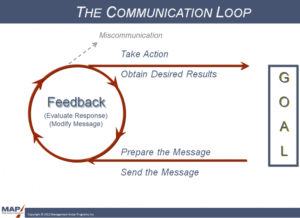Address Ambiguous Responses
As an astute accountability leader, beware of ambiguous responses from your team when asking for progress against goals and other critical communication. When you hear people say things like, “I will try,” “I will do my best,” or “I am working on it,” be on high alert. These potentially evasive responses imply a lack of commitment from the individual or possible problems that need to be surfaced. If ambiguous responses aren’t immediately addressed, then it sends the message that accountability and transparency aren’t important. So make a concerted effort to drill down on such responses, asking follow-up questions until you get the answers you need and achieve the desired degree of accountability.
If you think ambiguity is something to take lightly, consider that countries have long used it as an intentional tactic to confuse their enemies. There’s even a term for it, “strategic ambiguity,” whereby one government provides non-specific assertions or communications to another government in policy negotiations or discussions. Among other problems it can cause, ambiguity can undermine your leadership, prevent you from efficiently achieving goals, and negatively impact company morale, productivity and profitability.
Click here to download our free effective communication checklist.
Here are three steps to address it:1. Realize that ambiguity is a moment of truth.
So don’t blow right by it in meetings or when faced with other communication opportunities with your team. Embrace it as a chance to demonstrate accountability and reveal the truth about your leadership effectiveness. If you don’t, you could be perceived as soft—like a marshmallow! People will know they can “skate” an issue by offering ambiguous responses.
2. Drill down to the truth.
Part of what MAP teaches is that you’re not just a leader but an accountability leader—and that’s what’s going to make a difference in your ability to get your job done. Here’s how drilling down works…Manager: How are you doing against your goals this month?
Direct report: I’m working on it, no problem.
Manager: Please tell me what ‘working on it’ means?
Direct report: I’m making progress.
Manager: What kind of progress?
Direct report: I have secured several big sales.
Manager: How many is several?
Direct report: As of this week, I’m at $15,000 in total sales.
Manager: The goal is to have $40,000 by the end of the month, which is next Tuesday. How do you expect to make it?
Direct report: I will follow up with five other accounts today and close at least three deals by the end of the week.
The manager, who is the accountability leader in this scenario, now has accurate information. The manager got there by first drilling down to the truth. Doing so provides the much-needed transparency that will empower this manager to hold the direct report accountable.
3. Gain renewed agreement around the goal.
After you’ve drilled down and revealed a true understanding of the situation, revisit the goal and get confirmation from that direct report that he/she really gets what’s expected. Of course, the goal should be a S.M.A.R.T. one, as in Specific, Measurable, Achievable, Relevant and Time-Bound. Then assuming you’ve followed this approach with goal-setting, next get that direct report to consent to achieving it. For example:
Manager: I want to make sure there’s clarity on your goal—can you hit $40,000 by Tuesday?
If the direct report agrees, great! But if there’s no agreement, you’ll either need to revisit that drilling-down process until you get it or take appropriate, corrective action.What are some other signs, phrases or excuses you hear that commonly signal “ambiguity” on their part?



